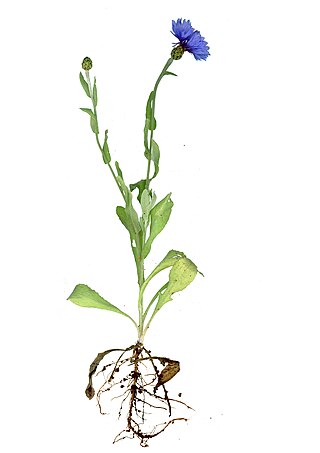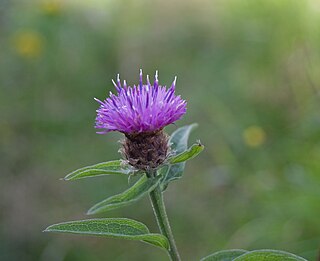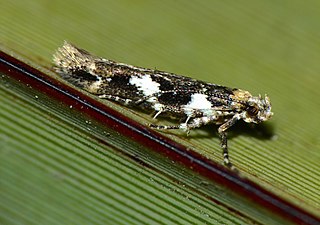
Centaurea is a genus of over 700 species of herbaceous thistle-like flowering plants in the family Asteraceae. Members of the genus are found only north of the equator, mostly in the Eastern Hemisphere; the Middle East and surrounding regions are particularly species-rich.

Centaurea cyanus, commonly known as cornflower or bachelor's button, is an annual flowering plant in the family Asteraceae native to Europe. In the past, it often grew as a weed in cornfields, hence its name. It is now endangered in its native habitat by agricultural intensification, particularly by over-use of herbicides. However, Centaurea cyanus is now also naturalised in many other parts of the world, including North America and parts of Australia through introduction as an ornamental plant in gardens and as a seed contaminant in crop seeds.

Centaurea scabiosa, or greater knapweed, is a perennial plant of the genus Centaurea. It is native to Europe and bears purple flower heads.

Centaurea montana, the perennial cornflower, mountain cornflower, bachelor's button, montane knapweed or mountain bluet, is a species of flowering plant in the family Asteraceae, endemic to Europe. It is widespread and common in the more southerly mountain ranges of Europe, but is rarer in the north. It escapes from gardens readily, and has thereby become established in the British Isles, Scandinavia and North America. This plant has become an invasive species in British Columbia, Canada. Centaurea montana grows in meadows and open woodland in the upper montane and sub-alpine zones, in basic areas. It grows to 30–70 centimetres (12–28 in) tall, and flowers mainly from May to August.

Boettger's lizard is a species of wall lizard in the family Lacertidae. The species is endemic to the Canary Islands. There are two recognized subspecies.
The Cosmopterigidae are a family of insects in the order Lepidoptera. These are small moths with narrow wings whose tiny larvae feed internally on the leaves, seeds and stems of their host plants. About 1500 species are described. The taxonomic family is most diverse in the Australian and Pacific region with about 780 species.

Centaurea jacea, brown knapweed or brownray knapweed, is a species of herbaceous perennial plants in the genus Centaurea native to dry meadows and open woodland throughout Europe. It grows to 10–80 centimetres (4–31 in) tall, and flowers mainly from June to September. It has simple leaves that are alternate in arrangement.

Centaurea nigra is a species of flowering plant in the family Asteraceae known by the common names lesser knapweed, common knapweed and black knapweed. A local vernacular name is hardheads.

Pyroderces is a genus of cosmet moths. It belongs to subfamily Cosmopteriginae. Some authors include Anatrachyntis here.
Anatrachyntis incertulella, the pandanus flower moth, is a small cosmet moth species. It belongs to subfamily Cosmopteriginae. This was the first "micromoth" species to be described from Hawaiʻi. The type specimens were collected there by the 1820s Beechey expedition and described by the English entomologist Francis Walker in 1864; they are now in the British Museum of Natural History.

Pyroderces wolschrijni is a moth in the family Cosmopterigidae. It is found in Spain, Morocco and on Malta. It has also been recorded from Crete, Sicily and the United Arab Emirates.

Pyroderces argyrogrammos is a moth in the family Cosmopterigidae. It is found from central Europe south to the Mediterranean area, the Canary Islands, North Africa, the Middle East, Central Asia and China. It has recently also been recorded on the Channel Islands.
Pyroderces brosi is a moth in the family Cosmopterigidae. It is found in Italy.
Pyroderces klimeschi is a moth in the family Cosmopterigidae. It is found in Poland, the Czech Republic, Slovakia, Austria, Hungary, Romania and Italy.

Pyroderces aellotricha, also known as the Cosmet moth, is a moth of the family Cosmopterigidae. It is found in New Zealand, in Australia and the Cook Islands.
Pyroderces nephelopyrrha is a moth of the family Cosmopterigidae. It is found in Taiwan and India.
Pyroderces apicinotella is a moth in the family Cosmopterigidae. It is found in Tunisia, Libya and Iraq.

Metzneria metzneriella is a moth of the family Gelechiidae. It is widely distributed throughout Europe, as well as Turkey and southern Siberia. The habitat consists of dry pastures and calcareous soils.

Pyroderces deamatella is a species of moth in the family Cosmopterigidae. It is endemic to New Zealand.
Pyroderces sarcogypsa is a moth in the family Cosmopterigidae first described by Edward Meyrick in 1932. It is found in Japan, the Russian Far East and the Chinese provinces of Fujian, Guizhou and Jiangxi.











